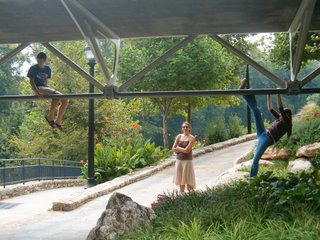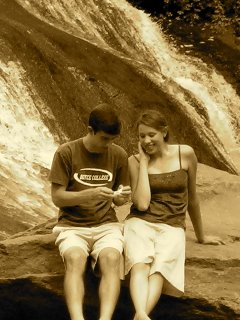In January, I will be heading to Italy on foreign study, with the Furman Communications and Religion Deptartments...neither of which contain my major. But the location (ITALY!!) and the subject
fascinate me. We're studying "the interplay of rhetoric (or theology, or worldview-- they're really all the same) and space." The actual course title is lovely, intriguing (at least I think so. But then again my boyfriend was laughing tonight about how glad he was to be dating a nerd, so no one else may find it either of the above)-- Religion 95: Rome, Ritual, and Sacred Space. Hmmm...
We had to read 2 books in preparation, and write papers on them (ahem ahem, 'nother story);
The Pantheon; design, meaning, and progeny (by George Macdonald), and
The Geometry of Love (by Margaret Visser). So far I've chugged my way through the first one, and managed to find it interesting, after I got past all the technical stuff. Hey-- did you know "entasis" is when columns are slightly curved out at their bottoms? Or that domes are amazing feats of engineering? I mean, how does this stuff stay UP? But I digress... since I've been thinking about this on and off for the past 2 weeks at least, I figured I'd share some of it here. It's opening my mind to things I never even thought of before. Maybe it will you, too.
Do all y'all know what the Pantheon looks like? It's the temple-looking building backed by a dome. Apparantly, the temple’s porch filled the enterer’s view as he approached, which was common for temples in those times. The Pantheon was a temple built by the Emperor Hadrian in around 126 AD, dedicated to "all the gods" (thence the name). So you'd walk up to this building thinking it was a normal temple, but no sooner had you crossed the porch, when came the unexpected. The contrasts between out and in were many and swift, effected through change in architecture (emphasis on the vertical outside--aka columns, centralized space within--aka the dome), color, and lighting—“Thus what appeared from the outside to be quite traditional design led to its antithesis, a revelation of another world.” As if that wasn't cool enough in and of itself, the shift forms an allegory of history, as well: the new Roman, centralized world, had only arrived after the classical world of the Greek. That really fascinates me. Are buildings really that much like books; architects that much like authors or composers? Is everything really put exactly and only where it is, for a reason? Do buildings really have a plot to them?
The MacDonald book prepared me to visit the Pantheon, and any historical site, firstly by giving me a vocabulary with which to describe what I will be seeing in Rome. For someone who has never studied architecture, words like “entasis” and “trabeation” are powerfully liberating; tools allowing me to put into words, and so be able to sort and process, what I will soon experience. It's why language is so cool! (oh, that is a whole separate post)
I’ve toured great buildings before—scores of castles, monuments, and cathedrals, and I’ve admired what I saw, but I never knew to ask “why? Why did they choose to build it this way? Why did they choose these colors, that design, this order?” I think my understanding of historical man was somewhat stereotypical, assuming our generation is the deepest-thinking, with the most options available to us. But this book reminded me that we stand on the shoulders of builders, thinkers, and architects of long ago. They were quite capable of being intentional; quite active in their working-out of their ideas; quite wealthy and resourceful. Even if they had to only “use what they had,” they were able to make whatever was at hand bend to their purpose quite capably. Our thought processes are merely the tail end of the momentum wrought by minds far greater than ours. It would be a discredit to them not to ask their legacies—the buildings, roads, and sculptures they’ve left behind—questions.
Have you ever thought to try and discern an architect’s worldview and presuppositions from his work? Have you ever stopped to wonder "why I am moved or affected by a space this way?" Have you ever tried to figure out how the architect brought that about, or what he was intending to "say" by the space he created? Honestly, the concept of “space” had never been a question of mine…I never stopped to question how space was set apart or defined, much less why. A wall had always been a wall, a door a door, an archway simply
there. I never stopped to consider that it could have not been there, or been there in a different way. Very little happens because it has to, I’m learning. We humans are far more assertive than that; we mold, we fashion, we seek to leave our mark, to make a name for ourselves—such is our nature as the Image of The Creator, such our nature as Fallen Glory-seekers, instead of Glory-bearers. It’s hard to tell what motivates us at times. All that to say that I’ve been reminded of the art that men put into the things they build to last, and have been reminded to be equally intentional about my touring of them as they were in the building of them.
Just some fodder for your thoughts! It's my goal in life to create more THINKING, especially in those whose neurons have been redeemed with precious blood!
--Christina...aka...Ryan's nerdy girlfriend. ;D











